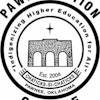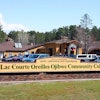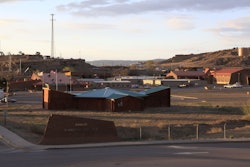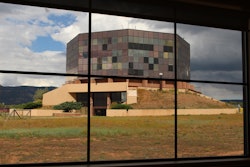Connecting the Disconnected
The Internet to the Hogan project will provide Web access to residents of a Navajo reservation.
By Mary Annette Pember
“I want to learn how to butcher the computer,” says Dody Begay, explaining her interest in participating in the Navajo Technical College’s new computer and Internet project. This parallel between the traditional Diné skill of sheep butchering and Internet access underscores the importance of the college’s new Internet to the Hogan and Diné Grid Project for the community. Raising sheep has deep roots in Diné culture. Butchering the animal for meat is an essential survival skill, passed down for generations. Begay, who is Navajo — or Diné as they call themselves — joined fellow NTC students and faculty as they conducted a presentation on the project at the annual American Indian Higher Education Consortium (AIHEC) conference in Rapid City, S.D., this spring.
The Internet to the Hogan project will provide Internet access to residents of the Navajo reservation who may have never had access to personal phones or electricity in their homes.
A hogan is a traditional Diné log home. According to Tom Davis, dean of instruction at the Crownpoint, N.M., college, the project “will end the digital divide in the eastern agency of the Navajo Nation.”
The Navajo reservation, which extends into Arizona, New Mexico and Utah, is slightly larger than West Virginia, covering more than 27,000 square miles. Road access to these communities, among the poorest in the nation, is often limited, and it’s not uncommon for reservation residents to travel more than 10 miles to draw water or use a telephone. Architects of the project say they hope that by narrowing or closing the digital divide, they can help spur advances in education, economics, health care and public safety.
“We are currently working under a $2.4 million grant,” says Davis, who helped create the AIHEC initiative. Most of the funding came from New Mexico State Senate Bill 1139 “Internet to the Hogan,” from the state’s Indian Affairs department. The bill was sponsored by then-state Sen. Leonard Tsosie of the Navajo Nation and supported by Gov. Bill Richardson, Davis reports. According to Jason Arviso, information technology director at the college, the project has just received an additional $1.5 million from the same source through the support of current state Sen. Linda Lovejoy, also a Navajo nation member.
In addition to state support, the college also received a grant for $400,000 from the Department of Defense designed to strengthen the STEM disciplines at tribal colleges.
The project has received funding from the National Science Foundation. The Internet to the Hogan Project began in response to an
initiative created by the AIHEC STEM committee seeking to end the digital divide at tribal colleges.
NTC has partnered with the Navajo Nation on the project and is collaborating with a diverse group of government, educational and private organizations to make this complex technological effort a reality. During the first phase, experts from the San Diego Supercomputer Center at the University of California-San Diego will help build a major wireless “pipe” from Albuquerque, N.M. The pipe would have sufficient capacity to transmit large amounts of digital information.
Then, students from the college will help build an extended mesh of wireless broadband towers throughout the reservation, which will provide connectivity to 52 chapter houses. Chapter houses are traditional gathering places on the reservation where residents often come to fill water barrels, make phone calls and access other resources not available at home. Canopy technology from Harris and Motorola companies will then allow wireless connectivity to be radiated out to schools, clinics, police departments, firehouses and homes within a 15- to 30-mile radius.
Tied into the broadband wireless connectivity effort is the construction of a unique supercomputing grid called “Little Fe,” a take on the computer slang term “big iron” for supercomputers. “Fe” refers to the periodic table of elements symbol for iron; thus, Little Iron. Little Fe is a cluster of processors that work together as a small supercomputer providing high-performance computing resources. Hubs will be located at each chapter house, allowing distribution of a super computer grid from the College. This would allow the chapter houses to have the same computing capacity as the college. The supercomputer technology will provide Navajo people access to information and data on a global scale, according to NTC database technician Chris Yazzie.
The possibilities and applications for the project are vast. Student users in very remote areas will have access to the colleges’ E-Learning programs, based on software called “Moodle.” Moodle is especially useful for teaching science, technology, engineering and math coursework, and NTC officials say it encourages students to collaborate over long distances. Currently, students may have to ride the bus for up to two hours to attend classes in Crown Point. With the Little Fe technology, chapter houses will become educational hubs, Davis says. Educators at NTC say they hope that their online content will create fundamental changes in the community by providing access to advanced scientific curricula and data resources. They envision helping to empower community members to make informed decisions about the environmental impacts of proposed activities on the reservation.
–Mary Annette Pember
There are currently 0 comments on this story.
Click here to post a comment.
© Copyright 2005 by DiverseEducation.com





















